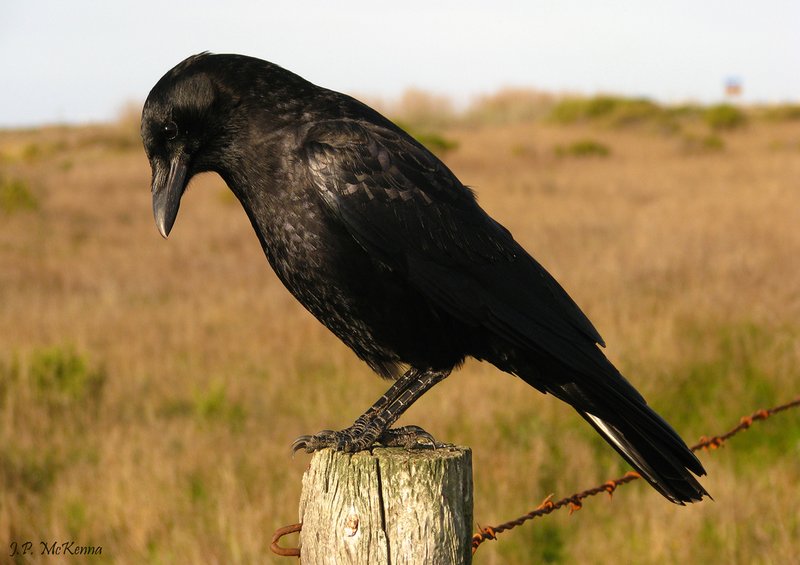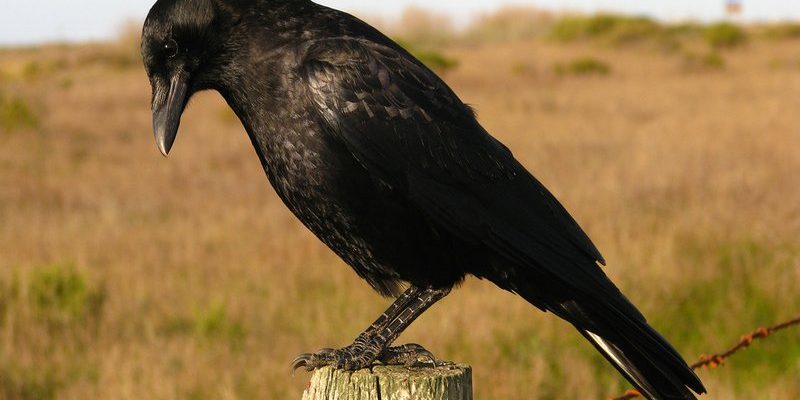
Crows are more than just ordinary birds; they’re intriguing creatures with remarkable intelligence and social behavior. You might spot them in parks, urban areas, or even in the wild, where they often steal the show with their unmistakable black feathers and sharp calls. But there’s so much more to these avian wonders than meets the eye.
Picture a crow perched on a branch, scanning its surroundings with an almost human-like curiosity. It’s no wonder these birds have fascinated people for centuries. They belong to the family Corvidae, which also includes ravens, magpies, and jays. Equipped with a level of intelligence that rivals that of some primates, crows are like the brainiacs of the bird world. They can solve complex problems, use tools, and even recognize human faces!
Physical Characteristics
The physical features of crows are striking and easily identifiable. Generally, they have a robust body, a rounded head, and a fan-shaped tail. Their glossy black plumage can shine with iridescent hues, especially in the sunlight. But what exactly sets them apart?
| Size: | 16-21 inches in length |
| Wingspan: | 32-40 inches |
| Weight: | 11-22 ounces |
| Life Span: | 10-15 years in the wild |
| Habitat: | Diverse environments like forests, grasslands, urban areas |
| Diet: | Omnivorous – insects, grains, fruits, small mammals |
These characteristics not only make crows unique but also allow them to adapt well to various environments. You might also notice their strong, powerful beaks, which are perfectly suited for cracking nuts or tearing apart food. Their eyes are keen, providing excellent vision that helps them spot potential food sources from a distance.
Behavior and Intelligence
When it comes to behavior, crows are known for their complex social structures and communication skills. They often live in family groups and can frequently be seen engaging in social activities, such as play-fighting or foraging together. But that’s just the tip of the iceberg.
One of the most fascinating aspects of crow behavior is their ability to use tools. For example, they can bend twigs to retrieve insects from tree bark or drop nuts on roads to let passing cars crack them open. This shows a level of foresight and problem-solving that many animals can’t achieve. Isn’t that impressive?
Moreover, crows have distinct calls and sounds that convey different meanings. They can sound warnings, call their mates, or even express curiosity. Researchers have noted that they can learn from each other, passing on knowledge about food sources or potential threats. It’s almost like having a university of crows, all sharing their experiences!
Habitat and Distribution
Crows are incredibly adaptable birds found in a wide range of habitats across the globe. You can find them in forests, wetlands, grasslands, and even bustling cities. Their ability to thrive in diverse environments speaks volumes about their resilience.
In terms of distribution, crows are present on every continent except Antarctica. They have become particularly adept at living among humans, scavenging for food in urban areas. This adaptability has allowed them to thrive where other birds may struggle. Think about it: while many animals shy away from the concrete jungle, crows seem to revel in it, using their wit to find meals!
In some regions, such as North America and Europe, you might notice various species of crows, including the American crow and the hooded crow. Each species may have slight differences in appearance and behavior, but they all share the same remarkable intelligence that makes them stand out.
Diet and Feeding Habits
Crows are omnivores, meaning they eat almost anything they can find. Their diverse diet includes insects, fruits, grains, and even small mammals. This flexibility in eating habits is one of the reasons crows can inhabit such a vast range of environments.
When it comes to feeding, crows are known for their clever foraging techniques. They can be seen using their environment to their advantage—like dropping hard shells on roads to crack them open or teaming up to distract predators while others access food. It’s like watching a live-action strategy game unfold right before your eyes!
Interestingly, studies have shown that crows can remember the locations of food they’ve hidden for later consumption. They use their exceptional memory to ensure their survival, returning to these secret stashes even months later. This intelligence not only aids them in finding food but also plays a crucial role in their social structure as they often share food with family or flock members.
Myths and Cultural Significance
Crows have long held a significant place in human culture, often surrounded by myths and folklore. Many societies view them as symbols of transformation, intelligence, or even mystery. You might have seen crows portrayed as omens in stories and movies, symbolizing death or bad luck.
Interestingly, in some cultures, crows are celebrated for their wisdom. Native American tribes, for example, often regard them as tricksters or messengers between the natural and spiritual worlds. This duality in how they are perceived adds an intriguing layer to their identity.
Furthermore, crows can often be seen in art, literature, and even music, showcasing their impact on human thought. Whether as harbingers of doom or wise teachers, the crow’s presence in culture reflects our fascination with this intelligent bird. It’s almost like they’re the original rock stars of the bird kingdom!
Conservation Status
Despite their adaptability and intelligence, crows face challenges in modern environments. Habitat loss and pollution can threaten their populations, just like many other wildlife species. However, their ability to thrive in urban areas gives them a somewhat stable status compared to more vulnerable bird species.
In some regions, crows are protected by laws that prevent hunting or trapping, underscoring their importance in ecosystems. They play a crucial role in the food web, scavenging waste and aiding in seed dispersal. Essentially, crows help maintain the balance of their environments.
Conservation efforts aim to ensure that these fascinating birds continue to thrive. By raising awareness and promoting coexistence with urban wildlife, we can help protect crows and their habitats for future generations. After all, who doesn’t want to share their neighborhoods with these intelligent creatures?
FAQ
What is the lifespan of a crow in the wild?
Crows typically live between 10 to 15 years in the wild. However, their lifespan can vary based on factors like environmental conditions, food availability, and threats from predators. In some cases, crows in protected areas have been known to live even longer!
How do crows communicate with each other?
Crows use a variety of sounds and calls to communicate. Each sound can indicate different emotions or messages, like warnings about threats or calls to gather the flock. They also have the ability to mimic human sounds and other noises, showcasing their adaptability and intelligence.
Are crows aggressive towards humans?
Crows are generally not aggressive towards humans unless they feel threatened. During nesting season, they may act defensively if they perceive a threat to their young. Most of the time, crows are curious and will observe humans without any hostility.
Can crows recognize human faces?
Yes, crows are capable of recognizing human faces. Research has shown that they can remember individuals who have treated them positively or negatively. If a person is kind to them, they may approach more readily; if not, they may keep their distance!
Do crows have a mating season?
Yes, crows have a mating season that typically occurs in late winter to early spring. During this time, they display courtship behaviors and often mate for life. Once paired, they work together to build nests and raise their young.
How do crows find food?
Crows use their keen eyesight and intelligence to locate food. They often forage in groups and can be seen searching through grass, pecking at the ground, or utilizing tools to access hard-to-reach food. Their ability to adapt their feeding strategies is remarkable.
Are crows social animals?
Crows are highly social creatures. They often form strong familial bonds and live in groups, displaying complex social interactions. Their social behavior can involve play, communication, and even cooperative feeding strategies, which adds richness to their lives in the wild.
Why are crows considered intelligent?
Crows are deemed intelligent due to their problem-solving skills, tool use, and ability to learn from experiences. Studies have showcased their capacity to plan for the future and adapt to new challenges. Their intelligence rivals that of some primates, making them fascinating subjects for research.
Can crows help in controlling pests?
Yes, crows can aid in controlling certain pest populations. As omnivores, they consume insects and small rodents, which can lessen the burden of pests in agricultural areas. Their scavenging habits also help in cleaning up carrion and waste, contributing to a healthier ecosystem.
How do crows build their nests?
Crows build nests with a variety of materials, including twigs, grass, and leaves. They typically construct their nests high in trees to protect them from predators. Both male and female crows participate in building the nest and caring for their young, showing their commitment to family.
Are crows protected by law?
In many regions, crows are protected under wildlife laws that prevent hunting and trapping. This protection acknowledges their important role in ecosystems and helps ensure their populations remain stable. However, regulations may vary depending on your location.
What are some interesting facts about crows?
Crows are known for their exceptional problem-solving abilities and can even play games. They have been observed dropping nuts on roads for cars to crack open and can recognize themselves in mirrors. Additionally, crows have been shown to have impressive long-term memory, recalling faces and locations even years later.

